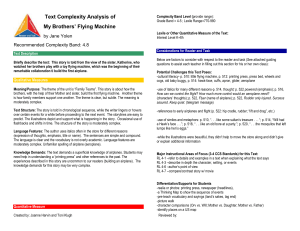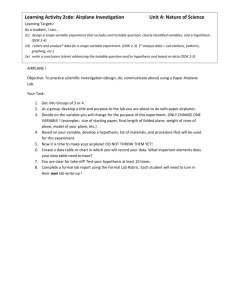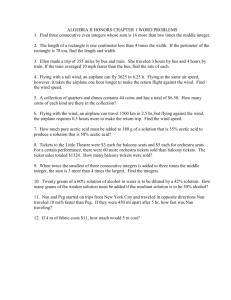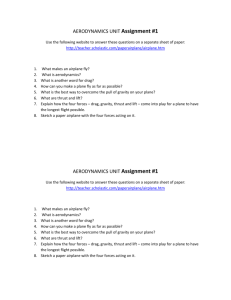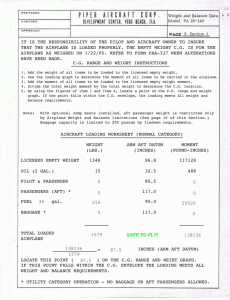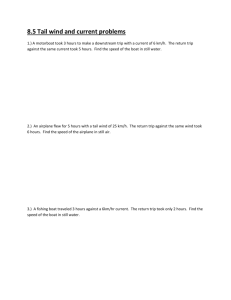Performance: Weight & Balance
advertisement
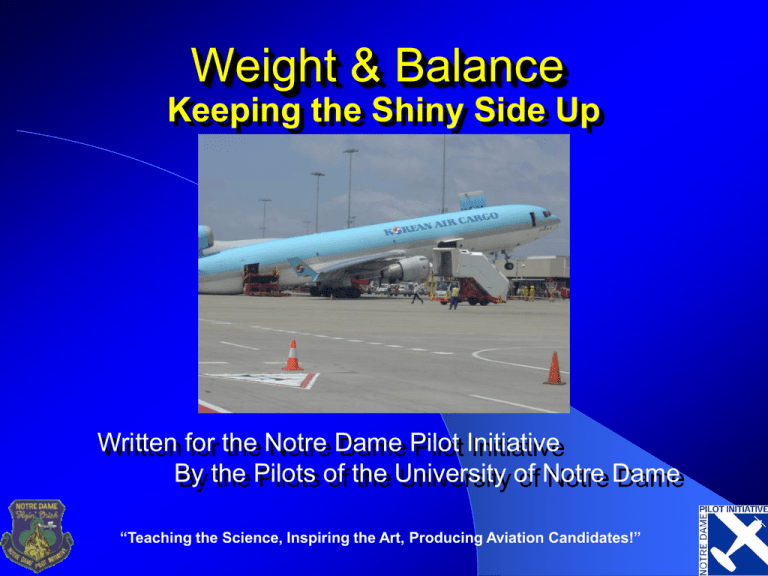
Weight & Balance Keeping the Shiny Side Up Written for the Notre Dame Pilot Initiative By the Pilots of the University of Notre Dame “Teaching the Science, Inspiring the Art, Producing Aviation Candidates!” Roadmap Terms Forces Mathematical Treatment Graphical Treatment Limitations An airplane must only be flown within certificated limits of weight and balance to ensure that it remains controllable, performs adequately and is not overstressed. Correct weight and balance means: Maximum allowable weight is not exceeded; and Center of gravity (CG) is within a specified range Terms Center of Gravity Point at which the airplane’s entire weight is assumed to be concentrated Center of Lift (Pressure) Point at which the airplane’s entire lift assumed to be concentrated Basic Empty Weight Generally, the weight of the airframe, unusable fuel, unusable/full oil, and full hydraulic fluid Forces The goal in flying any airplane is to always remain in positive control Knowing how the forces that act on our airplane balance helps us predict how it will fly AX = BY Moment arm of A Moment arm of B X Y A B Fulcrum Mathematical Treatment “Teaching the Science, Inspiring the Art, Producing Aviation Candidates!” Practical Exercise Joe (150) and Jeff (200) want to fly to Cocoa Beach. They decide to take Brady (231) with them for some extra practice with them. The golden helmets (15) are in the back seat and footballs (35) are in the baggage compartment. Are we good to go? Weight We want to add up all of the weights in our airplane Start with BEW Then we add usable fuel (and oil), passengers, and cargo FAA standard passenger is 170 lbs Always ascertain the proper weight of pax and cargo AVGAS is 6 pounds per gallon Oil is 7.5 pounds per gallon Water is 8.35 pounds per gallon Weight Empty Weight 1683 Useable Fuel 350 Front Seats 340 Rear Seats 15 Baggage Area 35 Takeoff Weight 2423 Balance The aircraft can only be controlled if it is positively stable. Maintaining the proper center of gravity assures us that the airplane will be controllable upon liftoff The Center of Gravity must be forward of the Center of Lift (Pressure) in order to achieve positive dynamic stability Loading Chart Balance Empty Weight 1,683 39.7 66,815 Useable Fuel 350 48.0 16,800 Front Seats 340 37.0 12,580 Rear Seats 15 73.0 1,095 Baggage Area 35 95 3,325 Takeoff Weight (lbs) 2,423 Total Moment (lb-in) C.G (in) 100,615 41.53 “WAM” Weight x Arm = Moment Total Moment / Total Weight = C.G Graphical Treatment “Teaching the Science, Inspiring the Art, Producing Aviation Candidates!” 63+12.5+12+2+3+1 = 93.5 lb-in Center of Gravity Envelope Stability & Control Center of Gravity concerns: Unable to compensate with elevator in pitch axis Weight and Balance becomes critical – stalls & landing Tricks of the Trade Flying with a rear CG is more efficient but decreases stability Flying with a forward CG decreases performance and makes flaring for landing more difficult, yet makes for a quick stall recovery Flying over gross weight may overstress the airplane and cause it to self-destruct Conclusions It is very easy to make an airplane unflyable by misloading it. When you fly outside of tolerance, you become a test pilot. Understanding weight and balance will allow you to maximize performance and understand poor performance Say Intentions One Passenger, No baggage, Full Fuel, Calm Winds, No Ceiling, PIC-25 hours Go for it Three Passengers, Full Fuel, Golf Clubs for 4 (10 each), Scattered T-storms, PIC-500 hours Calculations bring you right to max GW and a rear CG Go for it with that experience Second scenario again (Passengers are his grandmother, girlfriend, and the bosses 3 year old daughter), PIC-50 hours, 5 hours in an Archer No go, passengers are not easy to deal with, pilot has little experience in type, and the airplane will be difficult to control in turbulence Salmon 30 Salmon
